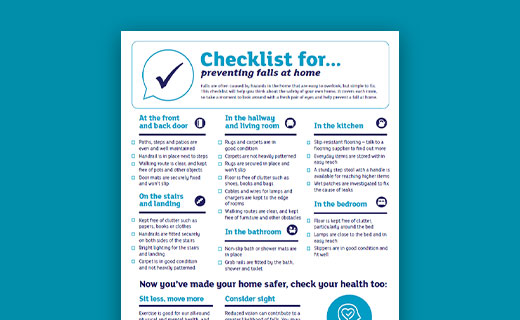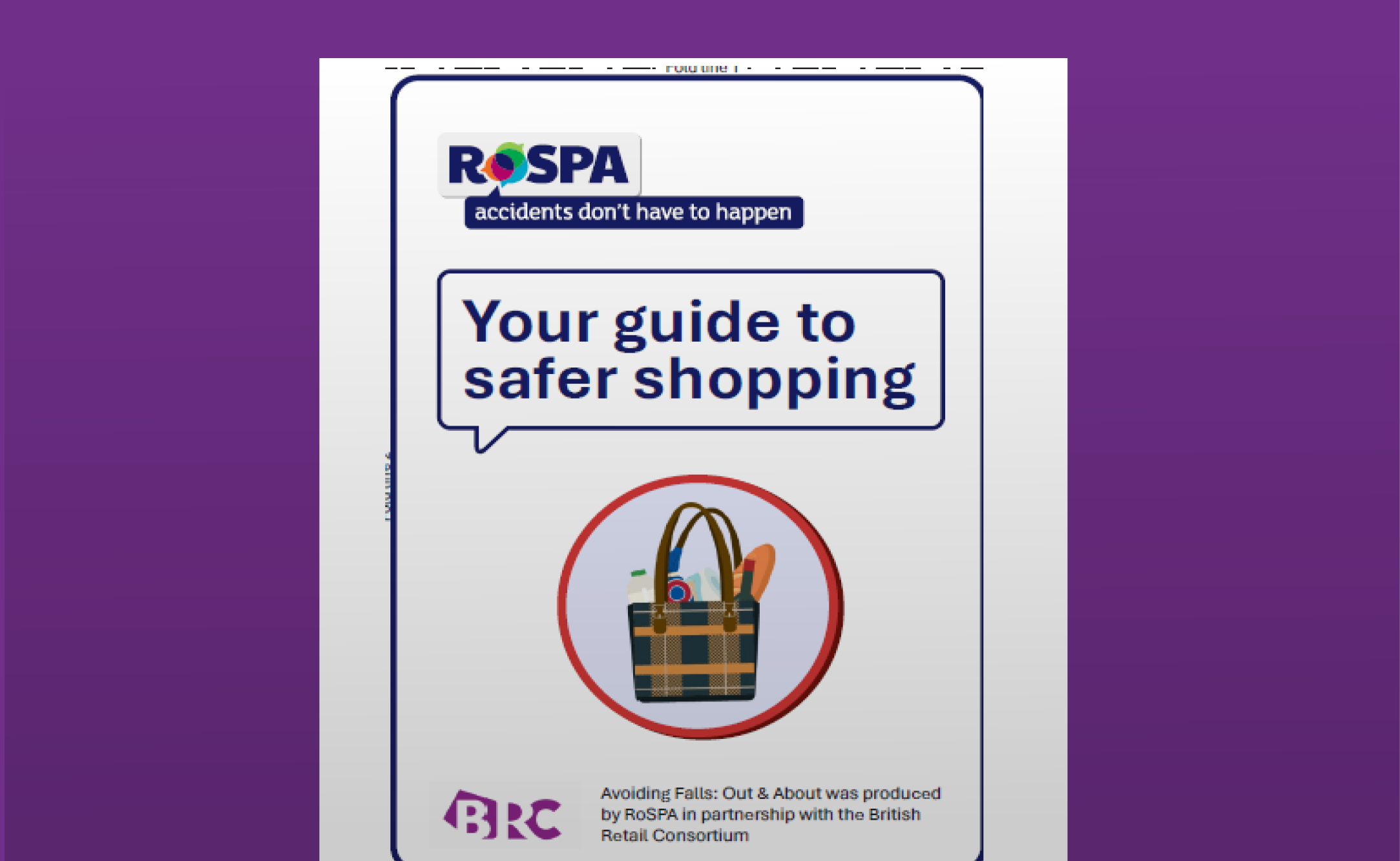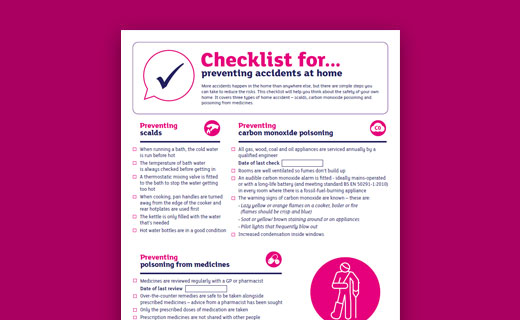
Advice for older people, and their friends
and family
Did you know you’re more likely to suffer a fall at home than anywhere else? Slips, trips and falls at home can happen for all sorts of reasons, but the good news is they can be avoided. While minor accidents cause discomfort and inconvenience, more serious falls lead to hundreds of thousands of hospital admissions every year. Across the UK every 15 minutes there are 2 people admitted to A&E with a hip fracture injury- almost always from a fall. Falls are responsible for four out of five accident-related hospital admissions among people who are aged over 65.
With these figures in mind, and the long-term impact that fall-related injury can have, it’s no surprise that older people have said slips, trips and falls at home are the accidents they’re most worried about.
How can falls be prevented?
The effective changes which reduce the risk of falling depend on the individual, their circumstances and surroundings. However, there are many common hazards around the home and risk factors in our lifestyles that offer quick wins for risk reduction.
Maintaining an active lifestyle, good levels of strength and balance, and managing health conditions can help you avoid a fall wherever you are.
Spotting hazards at home is also important. Knowing how to control hazards around your home using simple adjustments will help to minimise the risk of a fall. Proactively adapting your home environment if your needs change will help maintain safety, independence and dignity.

Fall Fighter
Want to become a RoSPA Fall Fighter?
Watch these videos about avoiding a fall
Finding out how to get up safely after a fall could also give you reassurance that you’d know what to do in the event of a fall happening.
Room by room falls prevention video
Preventing falls guide to safety aids
Avoiding falls out & about
How can I make my home safer?
Falls at home are often caused by hazards that can be easy to overlook, but simple to fix once spotted. It can help to use a checklist to help you identify hazards, and having a friend or family member to give a different perspective can also be useful.
-
Spot the hazard – take a look around your home and check for things that might cause injury
-
Find out how to reduce the risk – our Falls Hub and Fall Fighter awareness sessions have lots of tips on what you can do to reduce fall risk
-
Make the changes – most accidents can be avoided through simple changes to the home environment or how we live
-
Keep up the good work – maintain the changes you’ve made and monitor how effective they are. If new hazards arise follow these steps again!
Checklists
Why not download these handy checklists? Using a structured approach can help you spot hazards you might have previously overlooked.

Checklist for preventing falls at home
Falls are often caused by hazards in the home that are easy to overlook, but simple to fix

Checklist for avoiding falls out & about
Getting out and about is a wonderful way to stay active as we age. Here's some practical tips for adults who want to enjoy trips to the supermarket safely and confidently.

Checklist for preventing accidents at home
More accidents happen in the home than anywhere else, but there are simple steps you can take to reduce the risks
How to talk to family members or friends about safety?
When talking to a family member or friend about their safety, it’s important to be considerate of how your comments or observations might be received. A conversational approach will tend to get a better response, rather than being critical or judgmental.
Conversations about safety are best had at a time and place where you both feel relaxed and can give your full attention. Each person should have a chance to share their perspective including any concerns, and explain options or solutions. Discussing potential solutions and can spur the confidence needed to make a change in their home, or sign up to an activity they wouldn’t otherwise have joined.
Even with the best intentions you should avoid forcing changes on other people. Not only is it unlikely to be as effective compared to changes you agree together, but they might also undo or undermine the change adding strain to your relationship. Discussing and agreeing on proactive changes which work for everyone is best for safety, wellbeing, and peace of mind.
How to maintain strength and balance?
Regular light activity and movement throughout your day, coupled with some specific exercises that help to improve strength and balance can help you avoid a fall. Structured exercise programmes that are individualised to the person and progress in challenge over time offer the greatest benefits, but there are lots of things you can do at home to start to improve your strength and balance. There are options for doing exercises in a seated or standing position, and you don’t need any specialist equipment or kit.
We’re delighted to be working with Later Life Training, who are experts in strength and balance for fall prevention, to give you an introduction to these movements.
10 exercises for strength and balance
Circulation boosting
- Sit tall, hip walk the buttocks forwards to just past the centre of the chair
- Lightly hold the sides of the chair if you need to
- Using the ankles and feet, march the legs
- Build to a steady rhythm that feels comfortable
- Continue for one to two minutes
- Add the arm march, one arm at a time, keeping your posture lifted - you will feel the need to take slightly deeper breaths, but should not be breathless. This is the aim of the circulation boost
Stand up and sit down for strength
- Place the heels slightly behind knees
- Lift the trunk tall and ease slightly forwards
- Stand up (using hands on the chair for support if needed. Progress to no hands over time)
- Step back until legs touch the chair, then stand tall, bend knees and slowly lower bottom back into the chair
- Build to repeat two to three times, increasing to 10 times over time - and repeat across your day
Heel raises for strength
- Stand tall holding a sturdy table, counter or the sink
- Raise heels taking your weight over the big toe and second toe, hold for a second
- Lower heels to the floor with control
- Build to repeat three to five times, increasing to 10 times over time - and repeat across your day
Toe raises for strength
- Stand tall holding a sturdy table, counter or the sink
- Raise toes taking weight back on to heels, without sticking your bottom out
- Hold for a second or two
- Lower toes to the floor with control
- Build to repeat three to five times, increasing to 10 times over time - and repeat across your day
Turning with confidence - 180 degrees
- Stand side-on to a firm, fixed, reliable support, with hand on the support
- Feet hip width apart, weight even across both feet
- Feet balanced and confident before you start
- Take a few marches on the spot to feel confident and then start to turn the direction of the march towards your support
- Pick up the foot from the floor, replace and get your balance before you step again
- Keep feet hip width apart, this will provide more support during the turn
- Stop when you are facing the opposite direction to how you began (with your other hand on the support), pause and return back to start position.
Four positions of balance and extra steps practice
- Stand side-on to a firm, fixed, reliable support, with hand on the support
- Feet hip width apart, weight even across both feet
- Feel balanced and confident before you start
- Bring the feet closer together, try to hold this position - build to 10 seconds over time. Once you are successful with this position, try the next...
- With the leg farthest from the support, take a half step forwards, try to hold this position - build to 10 seconds over time. Once successful with this position, try the next...
- With the leg farthest from the support, step the foot in front of the other, as if walking on a tight rope
- Transfer weight across both of the feet, take extra steps at any time if you feel unsteady, build to 10 seconds over time. Once you are successful with this position, try the next...
- With leg farthest from the support, prepare to stand on one leg. Take half step behind and bending at the knee lift the foot from floor, replacing it to regain balance when needed.
Upper back squeezer (using a tea towel)
- Sit in upright position
- Fold a tea towel, grip palms up to trunk width
- Keeping the tea towel at belly button height (palms up), lift your chest up to open the posture and pull apart the tea towel to put mild tension through
- Keeping elbows "tucked in", squeeze the tea towel towards your tummy, elbows drawing behind you
- Feel the shoulder blades squeeze together
- Breath freely as you usually do
- Return to start position, releasse grip, relax posture for a moment and then repeat
Wall press/push up
- Stand at arms' length from wall
- Place hands on the wall at chest height, slightly wider than shoulder width, fingers upwards
- Keeping back straight and tummy tight, bend elbows lowering body with control towards the wall
- Press back to the start position
- Build to repeat two to three times, increasing to 10 over time, and repeat across the day when you feel you can
Directional stepping
- Stand side-on to a firm, fixed, reliable support, with hand on the support
- Feet hip width apart, weight even across both feet
- Feel balanced and confident before you start
- With leg farthest from the support, step the leg forwards, heel strike first, transfer your weight and step on to that leg
- Push back to start position
- With the same leg, step out to the side, ball of foot leading and contacting the floor first, transfer weight across both feet and then push back to start point
- With the same leg, take a small step behind, ball of foot contacting first, transfer the weight across both feet and then push back to start position
- Feel balanced before you step in any direction
- Take extra steps if you need to regain balance at any point
Flamingo swing
- Stand side-on to a firm, fixed, reliable support, with hand on the support
- Feet hip width apart, weight even across both feet
- Feel balanced and confident before you start
- Stand tall
- With the leg farthest from the support, bend and raise the knee slightly and with control swing the leg backwards
- Try one or two swings and build to five to six, put your foot down to the floor if you feel unsteady - this is a positive movement to rehearse!
- Turn slowly to repeat on other leg
Can I do strength and balance classes near where I live?
Strength and balance classes are organised in many areas which provide great opportunities to meet new friends and stay active. Lots of online classes are also available allowing people to join from home. Contacting your local council or community healthcare trust is a good place to start to find out what’s happening in your area. Later Life Training provides specialist exercise training to health and exercise professionals who work in strength and balance programmes and falls prevention services across the UK. Since March 2020, it has been running Make Movement Your Mission free on Facebook giving followers three daily “movement snacks”. These live and interactive sessions help keep people moving and support them to feel more confident in performing movements needed for everyday movement and daily activities. There is a vibrant community feel in this group and people join from across the UK and the world.
There are many exercise programmes that include strength and balance. The key is finding the right programme for you. Exercise instructors who have completed training as a Specialist Postural Stability Instructor or have completed the Otago Exercise Programme Leaders Award have all undergone specific training to deliver effective and safe strength and balance exercise.
The exercises shown on this webpage and in the associated videos are not designed as structured home exercise programme. You take responsibility for your own watching and taking part in the movements that are demonstrated. The authors and advisers of the movements accept no liability. Bex (Rebecca) Townley, Later Life Training, RoSPA and RSA Group are not responsible or liable for any injury or harm you sustain as a result of the resources, including videos, text and images, on this website. All content is provided for general information only, and should not be treated as a substitute for the medical advice of your own GP or any other health care professional.